Life is how the 2018 subsidy might change in the watershed
According to past practice, the new energy vehicle subsidy (hereinafter referred to as “subsidyâ€) policy should have an action at the end of each year. Vaguely remember that in 2017, a subsidence-type slope retreat occurred, and the rate dropped by 40%. Will such a dip-like subsidy deduction be seen in the new 2018 policy? Will it cost tens of thousands more when it comes to buying new energy vehicles next year? Today, we take a look at the 2018 subsidy policy that has not been formally fixed in the current network.
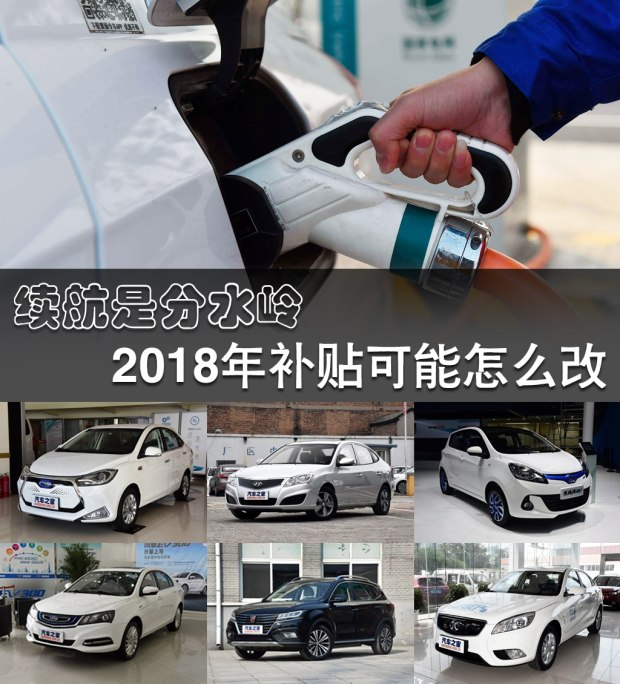
â— Online Subsidy Policy Adjustment Plan for Multiple Versions of 2018
At about the beginning of November, different versions of the 2018 subsidies adjustment program came out on the Internet. Let's look at the earlier version first. In this version, both state subsidies and local subsidies are explained. The state subsidy component has a relatively large change from the 2017 policy, and local subsidies may still use the standard that this year is no more than 0.5 times the national subsidies.
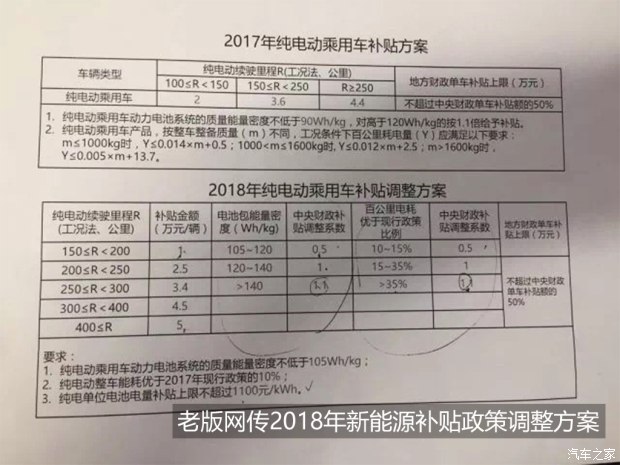
The above figure is an old version of the 2018 new energy vehicle subsidy adjustment plan that was previously circulated on the Internet. It is not difficult to see from the photos that the standards for measuring how much the state subsidizes have been improved and refined, including cruising range, power battery pack energy density, and 100 kilometers of power consumption. It is worth noting that the threshold for subsidy cruising mileage mentions 150km from 100km.
Recently, we have found new news about the network subsidy adjustment program for 2018: The latest version of the subsidy policy for network transmission, although the subsidy criteria are still consistent with the previous version, but there are more obvious indicators. Changes.
â— How will the adjustment of the subsidy policy of the new version of Internet in 2018 affect subsidies?
Regardless of the differences in the subsidy policies of the new and old versions of the Internet in 2018, what is sure about the possible changes in the subsidy amount? According to the latest version of the 2018 subsidy adjustment program we have learned, the subsidy amount will show a downward slope, and the maximum reduction can reach 45%; the model with a battery life of 200km or less; The maximum amount of subsidies for these models will increase by 25%. Below, we will give you one example at a time according to different levels of subsidy.
â—‹ Subsidy for cruising range of 150km-200km may be reduced
According to the division of the mileage of the Ministry of Industry and Information Technology, we will first look at the models with the lowest mileage of the Ministry of Industry and Immigration, which is higher than 150km but less than 200km, such as the JAC iEV7.
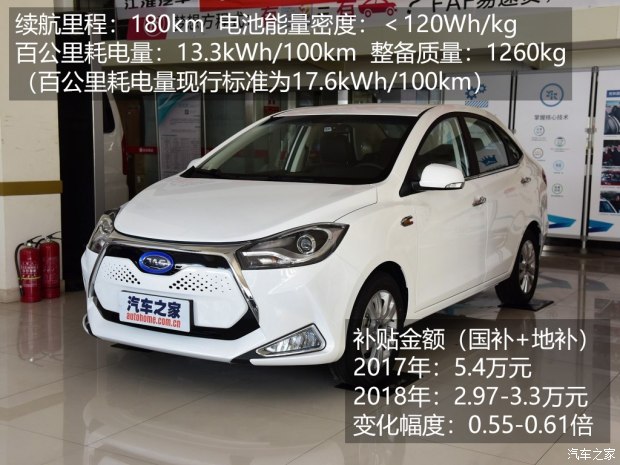
How did the final subsidy amount come from? We calculate it for everyone. The calculation method refers to the standard in the latest version of the network transmission subsidy adjustment scheme in 2018, which is different from the old version in the previous picture. The minimum amount of state subsidies is 20,000 yuan. Therefore, please do not refer to the previous picture for the value of the subsidy. . In addition, the local subsidy is based on the Beijing area as an example, and the national subsidy is calculated based on the standard of local subsidy = 1:0.5.
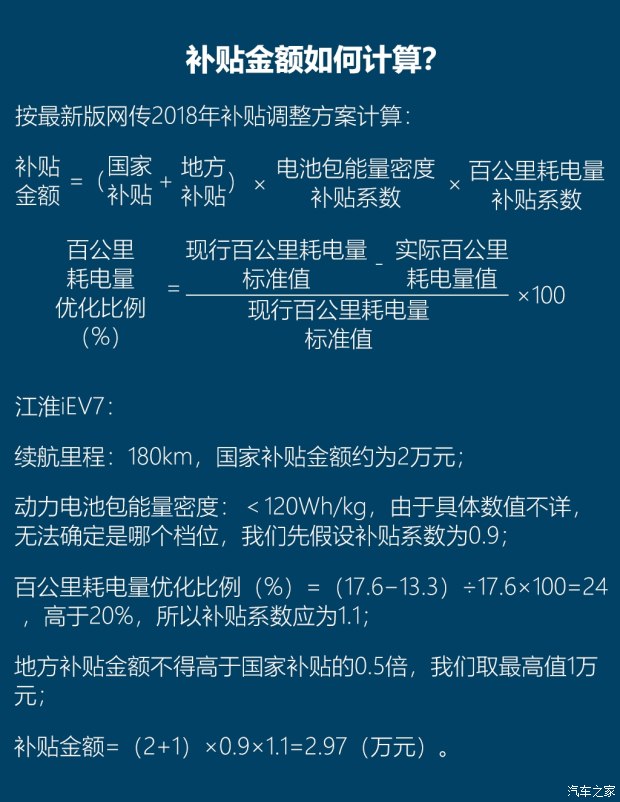
The calculation process is obviously very tedious. Then we only look at the final result. If the subsidy of Jianghuai iEV7 is calculated according to our calculation method, the subsidy that can be obtained in 2018 is about 2.97-3.3 million yuan, which is less than the amount of subsidies in 2017. 45% -39%, the amount of subsidy is still a lot less.
â—‹ Subsidy for cruising range 200km-250km may be reduced
Next, let's take a look at the models that the Ministry of Industry and Information Technology has cruising range of 200km, but less than 250km, such as the 210km version of the Changan Benben EV.
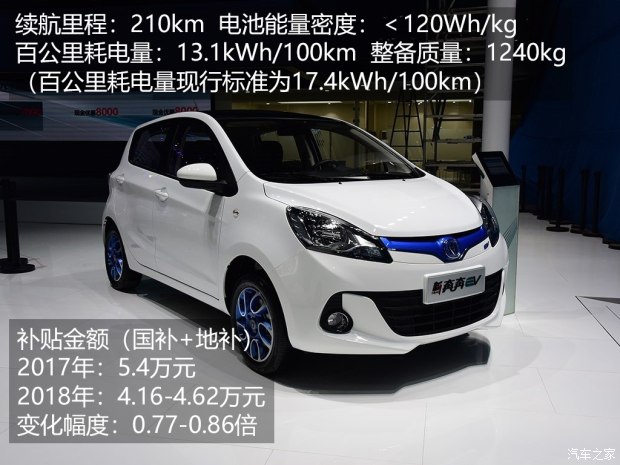
The calculation method is basically the same as that of the previous model, so we still look at the result directly. Interested friends can calculate according to the previous formula and the data in the above figure. The final subsidy for this model will be approximately RMB 41-46,200 in 2018; it will be reduced by 23-14% compared with the amount of subsidy in 2017, and the amount of subsidy will be reduced. However, it is better than the models with a range of less than 200km. .
â—‹ Subsidy may not change when the cruising range is between 250km and 300km
Let’s look at models with cruising range of the Ministry of Industry that meets 250km and less than 300km, such as Beijing Hyundai Elantra EV.
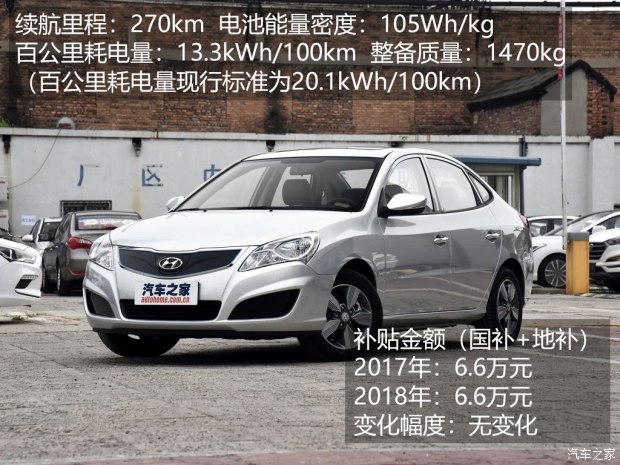
Beijing Hyundai Elantra EV expects the subsidy amount of about 66,000 yuan in 2018; it is no different from the subsidy amount in 2017, which means that the vehicle with this endurance level may not be paid or won for the next year.
â—‹ The subsidy may be increased when the cruising range is between 300km and 350km
Next is the model that the Ministry of Industry and Information Technology's cruising range meets 300km and less than 350km. We refer to the Geely emgrand EV300.
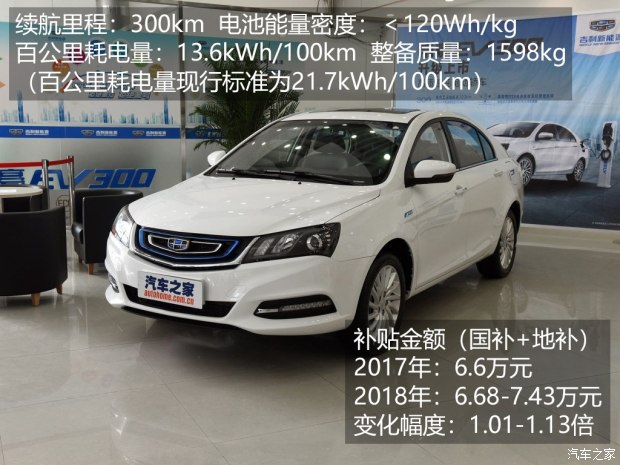
Geely Dorsett EV300 expects the subsidy amount in 2018 to be approximately RMB 66-47.43 million; it will increase by 1%-13% compared with the amount of subsidy in 2017, so the price of this life-grade vehicle may be small after the subsidy in 2018. With the reduction in magnitude, friends who are ready to buy this life-level model can take a small look.
â—‹ Subsidy may increase if the cruising range is greater than 350km
Finally, the models with cruising range above 350km from the Ministry of Industry and Information Technology, such as Beijing Auto New Energy EU400.
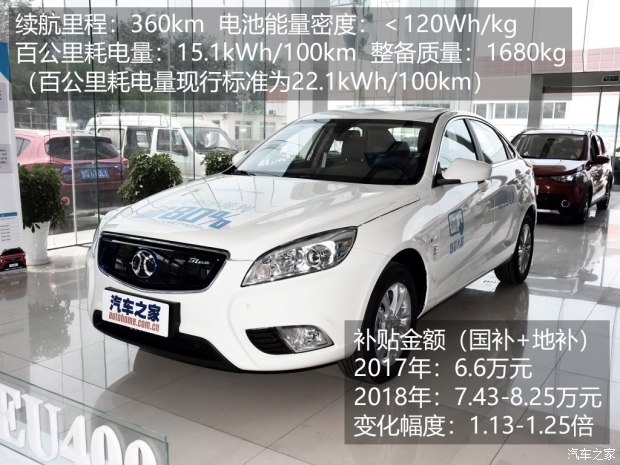
Beiqi New Energy EU400 is expected to have a subsidy amount of approximately RMB 74-82.50 million in 2018; an increase of 13%-25% compared to the 2017 subsidy. It seems that the price of vehicles with a battery life of over 350km in the next year should have a certain degree of price reduction. This should be a good news for friends who have long-term purchase needs.
â—‹ Subsidy for vehicle models that may have a 1.1-fold battery energy subsidy may increase
In the above, we only talked about the battery life, so what is the situation for the high-subsidy vehicle battery pack energy density? Let's take a look at the Roewe ERX5 EV400 with 135.3Wh/kg power battery pack.
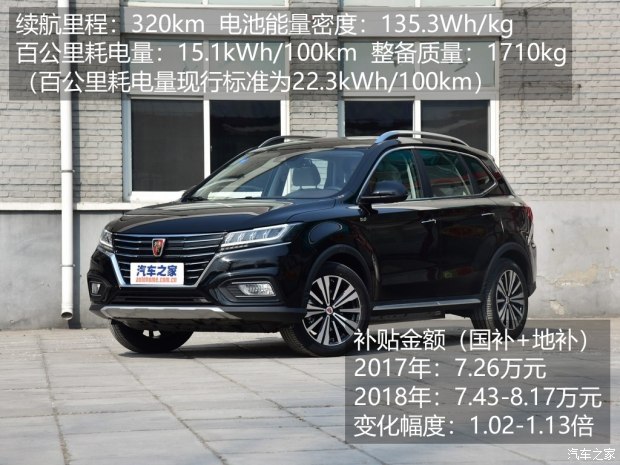
If the subsidy in the 2018 subsidy of the highest power battery pack energy standard is 1.1 times higher than the 135Wh/kg subsidy calculation, the subsidy amount of the Roewe ERX5 EV400 is approximately 81,700 yuan, an increase of 13% over the 2017 subsidy. There is also a certain increase compared with the same life level model, but the difference is not too great.
From the above analysis, it can be concluded that the subsidies for 2018 will increase or decrease for most of the purely electric vehicles, mainly depending on the length of the cruising range. The longer the cruising ability, the more likely the vehicle will be subsidized; on the contrary, the longer the cruising ability For short models, there may be substantial subsidies for slope retreat.
Subsidy for 2017 vs. Networking Subsidy for 2018 Model Subsidy for 2017 (10,000 yuan) Net subsidy amount for 2018 (RMB million) Change rate Jianghuai iEV7 5.4 2.97-3.3 0.55-0.61 times (price may increase after subsidy) Chang An Ben The EV 210 km version 5.4 4.16-4.62 0.77-0.86 times (the price may increase after subsidy) Beijing Hyundai Elantra EV 6.6 6.6 No change (the price may not change after subsidy) Geely Dorsett EV300 6.6 6.68-7.43 1.01-1.13 times (after subsidy Prices may decrease) Beijing Auto New Energy EU400 6.6 7.43-8.25 1.13-1.25 times (subsidy price may decrease) Roewe ERX5 EV400 7.26 7.43-8.17 1.02-1.13 times (subsidy price may decrease)The subsidy change of pure electric vehicles is so lively, the subsidy change of the plug-in hybrid vehicle appears to be “lightâ€. In terms of technical requirements, the plug-in hybrid vehicle model still uses the standard that the Ministry of Industry and Information Technology can earn subsidy for purely electric cruising mileage of 50km or more, but the subsidy amount is reduced from 24,000 yuan to 22,000 yuan. As the amount of adjustment is not large, the time spent buying a car should not cost much more than this year.
In addition to the models we listed above for everyone, there are many uncovered models. If you are interested in the details of how other models may be subsidized in 2018 and the details of the network version of the policy adjustment plan, then you can continue to move down. Look, there will be more detailed description and analysis below. However, the following content is relatively boring and the friends looking down still have to be mentally prepared.
â— Three characteristics of the new version of the network transmission subsidy policy adjustment plan in 2018
â—‹ Feature 1: The subsidy threshold is improved and the gear division is more detailed
Ministry of Industry and Information Technology, Interval Range (R) Value Division and Subsidy Standards
Ministry of Industry and Information, Mileage (km) Current National Compensation Amount in 2017 (10,000 yuan) Net Passage in 2018 (RMB million) Change100≤R<150
2 01. The subsidy threshold has been raised from 100km to 150km; the highest subsidy standard has been increased from 250km to 350km.
2.Different subsidy value ranges are more detailed and adjusted from 3 to 5
150≤R<200 3.6 2 200≤R<250 2.8 250≤R<300 4.4 4 300≤R<350 4.5 R≥350 5It is not difficult to see that the latest version of the network subsidy adjustment scheme in 2018 is similar to the old version in terms of subsidy adjustment scheme for different subsidized gears. Compared with the old version, the division of the mileage range of different subsidy gears is also more meticulous. In 2017, there were only three gear division standards, increasing to 5 files. The minimum standard for obtaining subsidies was increased from 100km in 2017 to 150km, while the standard for the highest-grade subsidies was also increased from 250km to 350km. From the improvement of technical requirements, it can be seen that with the continuous improvement of new energy vehicle technologies, those products that have short cruising range and are not practical will also be eliminated. The same is true for the basic user needs of pure electric vehicles. After all, it is not enough to produce products that have short cruising range and cannot meet travel needs.
â—‹ Feature 2: Increased battery technical requirements
90-100
0.9 100-135 or 140 1 >120 1.1 >135 or 140 1.1From the subsidy standard for the energy density of power battery packs, it can be seen that not only the value ranges for different subsidy standards are subdivided, but also the technical requirements for power batteries are improved. In the 2017 subsidy standard, as long as the power battery pack energy density exceeds 120Wh/kg, 1.1 times the subsidy amount can be obtained; while the network transmission 2018 subsidy standard raises the technical standard of obtaining 1.1 times subsidy to 135Wh/kg or 140Wh/ Only kg can be obtained (since the subsidy has not been finalized yet, the most upscale standard values ​​have not been determined). At the same time, the subsidy standard has set a "minus item", that is, the power battery pack has an energy density of 90-100Wh/kg, and the subsidy coefficient is 0.9. Of course, the higher the energy density of the power battery pack, the more powerful the power battery pack is to download the power, and the user can reduce the charging frequency without changing the habit of the vehicle. From the user level, the establishment of this standard is also to improve the practicality of pure electric vehicles.
â—‹ Feature 3: Electronic control system requires more energy-saving
In addition to subdividing the technical requirements for cruising range and energy density of power battery packs in the network transmission 2018 subsidy standard, the technical requirements for 100 kilometers of power consumption have also been increased.
In the 2017 subsidy standard, the assessment of the electricity consumption per hundred kilometers is based on the quality of the entire vehicle. With specific algorithms, different limits for the power consumption of 100 kilometers are required for vehicles in different conditioning ranges. And due to the different quality of the trim, the specific upper limit value of each model will be different.
2017 100 km power consumption allowance standard vehicle curb weight (m) NEDC conditions 100 km power consumption (Y) requirements to be met m ≤ 1000 kg Y ≤ 0.014 × m + 0.5 1000 <m ≤ 1600 kg Y ≤ 0.012×m+2.5 m>1600 kg Y≤0.005×m+13.7According to the requirements of 100 kilometers of power consumption in the next year based on network news, the division of the quality of maintenance continues to use the 2017 standard, but there is a higher demand for the optimization of 100 kilometers of power consumption.
For example, for a vehicle with a mass of 1,000 kg, its 100 km power consumption standard is calculated as follows: 0.014 × 1000 + 0.5 = 14.5. Then, its actual electricity consumption per 100 kilometers = the capacity of the Ministry of Industry and Information Industry, cruising range × 100, to be below 14.5 kWh/100km before the subsidy can be obtained. This standard sets a threshold for 100 kilometers of vehicle power consumption.
With the development of technology, not only the threshold of the standard has to be increased, but also a "good difference". Therefore, the power consumption per 100 kilometers of all models must be optimized in order to get subsidies. The criteria for the assessment items of the Internet in 2018 will become the following.
Network transmission 100 km power consumption subsidy standard 100 km power consumption optimization ratio subsidy coefficient 100 km power consumption optimization ratio lower than 10% 0.9 100 km power consumption optimization ratio between 10%-20% 100 Km power consumption optimization ratio greater than 20%1.1
We still take the example of a vehicle with a preparation quality of 1000kg. In 2017, it needs to reach a power consumption of 14.5kWh/100km per 100km. In the network transmission standard of 2018, its power consumption per 100km needs to be reduced at least. 10%, that is, to achieve 13.05kWh/100km to get the full amount of subsidies. If the optimization ratio is less than 10%, only 0.9 times of subsidies can be obtained. If the 100 km power consumption optimization is relatively good, and is higher than 20% of the current standard in 2017, it will be able to receive a 1.1-fold subsidy.
In order to facilitate the calculation, we just assume that the quality of the vehicle is 1000kg. For example, because the curb quality of each model is different, the value of the 100km power consumption is not the same. The implementation of this standard is mainly to make the electric control system of pure electric vehicles more energy-efficient, allowing users to run longer mileage after one charge.
Above, we have described the network subsidy version of the subsidy in 2018. However, these specific details have not yet been finalized, but the general direction of change may be similar to the current version.
Edit summary:
From the network's latest version of the 2018 subsidies adjustment program, it is still mainly based on the endurance capacity as an assessment index of how much subsidies, while the subsidy threshold increases, the demand for high-end subsidies can also get more stringent. The government’s policy guidance is intended to urge the development of new energy companies. Those products that have problems in terms of mileage, electronic control technology and other issues will eventually be eliminated. This is a good thing for the user. It means that you can buy more and more useful models, and you won't dare to say that you have gone to buy a "small leg."
In terms of prices, if we look at the latest version of the network subsidy adjustment and our analysis, it is expected that the subsidy for mini vehicles with short battery life will be significantly reduced in 2018. After subsidy without manufacturers, the subsidized price of such vehicles will be considered. There should be a substantial increase, and you may spend more than one-third of this year buying a model that does not last long. This may affect the ability of consumers, the target model will be locked into smaller vehicles with longer battery life and even compact cars. It is worth mentioning that, regardless of the final adjustment results of the 2018 subsidy policy, the trend of encouraging long-term purchase and high energy density of power battery packs has basically been established. Therefore, if there is a consumer demand for car in this area, they may enjoy the benefit brought by the policy after the subsidy price next year.
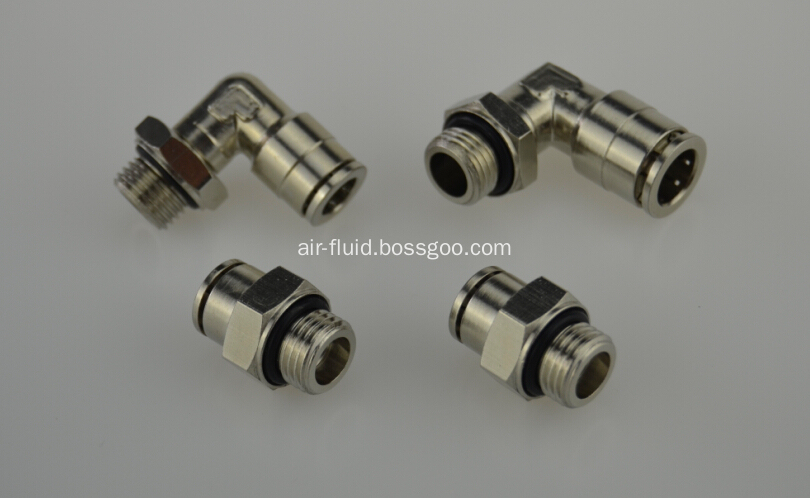
Cixi Air-Fluid Company 'BSPP Thread Metal Pneumatic Push In Fittings with below characteristics:
BSPP Thread Introductions : The British Standard Pipe Parallel (BSPP Threads )have the same diameter from end to end ,A parallel thread typically seals with use of an o-ring or Back Washer to seal the fittings ,no use of Anaerobe. The sealing ring (O-ring) can be easily replaced if it is damaged or hard-worn with time. Connection and disconnection of the tube can be repeated and can be performed using one hand , no other tools required .
Thread Connection : Range from BSPP 1/8" to 1/2"
Push-in Connection: Range from Inch Size 5/32" to 1/2" OD & Metric Size 04mm to 16MM
Configurations Includes: Straight , Elbow , Branch Tee ,Run Tee, Long Leg Male Elbow and Speed Control Valve .
Metal Pneumatic Push In Fittings BSPP
Metal Pneumatic Push In Fittings BSPP, Pneumatic Push In Fittings, Metal Pneumatic Fittings
Ningbo Air-Fluid Pneumatic Components Co., Ltd , http://www.air-fittings.com